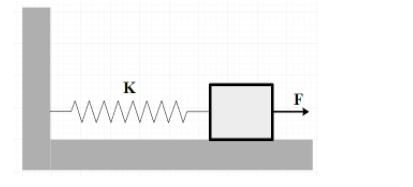
A block of mass \[m\] is connected to a spring of force constant \[k\]. Initially the block is at rest and the spring has natural length. A constant force \[F\] is applied horizontally towards the right. The maximum speed of the block will be (there is no friction between block and the surface)

\[\begin{align}
& A)\dfrac{F}{\sqrt{2mk}} \\
& B)\dfrac{F}{\sqrt{mk}} \\
& C)\dfrac{\sqrt{2F}}{\sqrt{mk}} \\
& D)\dfrac{2F}{\sqrt{2mk}} \\
\end{align}\]

Answer
575.7k+ views
Hint: We will use the expression given for force on a spring. This force is directly proportional to the displacement of the body. Then we will apply the law of conservation of energy which gives the work done due to the force equal to the total energy of the body. Total energy of the body comprises the kinetic energy of the mass and the energy due to the spring.
Complete step by step answer:
We will redraw the diagram for better understanding of the situation.

Now, the distance moved by the force will be equal to \[\dfrac{F}{k}=x\]from the restoring force equation.
We will find the work done by the applied force, which is given as,
\[W=F.x\]
Where, \[F\]is force applied and \[x\] is the distance moved by the object. But we found the expression for distance moved by using the formula for restoring force. Hence, work done by the force will be,
\[W=F\times \left( \dfrac{F}{k} \right)=\dfrac{{{F}^{2}}}{k}\]
Now, the total energy of the body will be the sum of kinetic energy due to the movement and potential energy due to the spring which is given as,
\[{{E}_{t}}=\dfrac{1}{2}m{{v}^{2}}+\dfrac{1}{2}k{{x}^{2}}\]
This energy will be equal to the work done by the force. We will equate the two expressions and then find the expression for velocity of the body.
\[\begin{align}
& \Rightarrow W={{E}_{t}} \\
& \Rightarrow \dfrac{{{F}^{2}}}{k}=\dfrac{1}{2}m{{v}^{2}}+\dfrac{1}{2}k{{x}^{2}} \\
& \Rightarrow \dfrac{{{F}^{2}}}{k}=\dfrac{1}{2}m{{v}^{2}}+\dfrac{1}{2}k{{\left( \dfrac{F}{k} \right)}^{2}} \\
& \Rightarrow \dfrac{{{F}^{2}}}{k}-\dfrac{1}{2}\dfrac{{{F}^{2}}}{k}=\dfrac{1}{2}m{{v}^{2}} \\
& \Rightarrow \dfrac{1}{2}\dfrac{{{F}^{2}}}{k}=\dfrac{1}{2}m{{v}^{2}} \\
& \Rightarrow {{v}^{2}}=\dfrac{{{F}^{2}}}{mk} \\
& \Rightarrow v=\dfrac{F}{\sqrt{mk}}={{v}_{\max }} \\
\end{align}\]
Therefore, the maximum velocity of the body when a force \[F\]is applied on the body is found to be\[\dfrac{F}{\sqrt{mk}}={{v}_{\max }}\]. So, option b is the right choice.
Note:
We must know that the maximum velocity of the body will be at the equilibrium position so as the kinetic energy. If friction is present between the block and the surface, there will be an opposing force acting to the opposite direction of the movement of the body. This will retard the motion and finally bring it to rest. So, if friction is present, the maximum velocity will be at the earliest stage of the motion.
Complete step by step answer:
We will redraw the diagram for better understanding of the situation.

Now, the distance moved by the force will be equal to \[\dfrac{F}{k}=x\]from the restoring force equation.
We will find the work done by the applied force, which is given as,
\[W=F.x\]
Where, \[F\]is force applied and \[x\] is the distance moved by the object. But we found the expression for distance moved by using the formula for restoring force. Hence, work done by the force will be,
\[W=F\times \left( \dfrac{F}{k} \right)=\dfrac{{{F}^{2}}}{k}\]
Now, the total energy of the body will be the sum of kinetic energy due to the movement and potential energy due to the spring which is given as,
\[{{E}_{t}}=\dfrac{1}{2}m{{v}^{2}}+\dfrac{1}{2}k{{x}^{2}}\]
This energy will be equal to the work done by the force. We will equate the two expressions and then find the expression for velocity of the body.
\[\begin{align}
& \Rightarrow W={{E}_{t}} \\
& \Rightarrow \dfrac{{{F}^{2}}}{k}=\dfrac{1}{2}m{{v}^{2}}+\dfrac{1}{2}k{{x}^{2}} \\
& \Rightarrow \dfrac{{{F}^{2}}}{k}=\dfrac{1}{2}m{{v}^{2}}+\dfrac{1}{2}k{{\left( \dfrac{F}{k} \right)}^{2}} \\
& \Rightarrow \dfrac{{{F}^{2}}}{k}-\dfrac{1}{2}\dfrac{{{F}^{2}}}{k}=\dfrac{1}{2}m{{v}^{2}} \\
& \Rightarrow \dfrac{1}{2}\dfrac{{{F}^{2}}}{k}=\dfrac{1}{2}m{{v}^{2}} \\
& \Rightarrow {{v}^{2}}=\dfrac{{{F}^{2}}}{mk} \\
& \Rightarrow v=\dfrac{F}{\sqrt{mk}}={{v}_{\max }} \\
\end{align}\]
Therefore, the maximum velocity of the body when a force \[F\]is applied on the body is found to be\[\dfrac{F}{\sqrt{mk}}={{v}_{\max }}\]. So, option b is the right choice.
Note:
We must know that the maximum velocity of the body will be at the equilibrium position so as the kinetic energy. If friction is present between the block and the surface, there will be an opposing force acting to the opposite direction of the movement of the body. This will retard the motion and finally bring it to rest. So, if friction is present, the maximum velocity will be at the earliest stage of the motion.
Recently Updated Pages
Master Class 11 Business Studies: Engaging Questions & Answers for Success

Master Class 11 Computer Science: Engaging Questions & Answers for Success

Master Class 11 Maths: Engaging Questions & Answers for Success

Master Class 11 Chemistry: Engaging Questions & Answers for Success

Master Class 11 Economics: Engaging Questions & Answers for Success

Master Class 11 Accountancy: Engaging Questions & Answers for Success

Trending doubts
What is meant by exothermic and endothermic reactions class 11 chemistry CBSE

10 examples of friction in our daily life

One Metric ton is equal to kg A 10000 B 1000 C 100 class 11 physics CBSE

1 Quintal is equal to a 110 kg b 10 kg c 100kg d 1000 class 11 physics CBSE

Difference Between Prokaryotic Cells and Eukaryotic Cells

What are Quantum numbers Explain the quantum number class 11 chemistry CBSE




